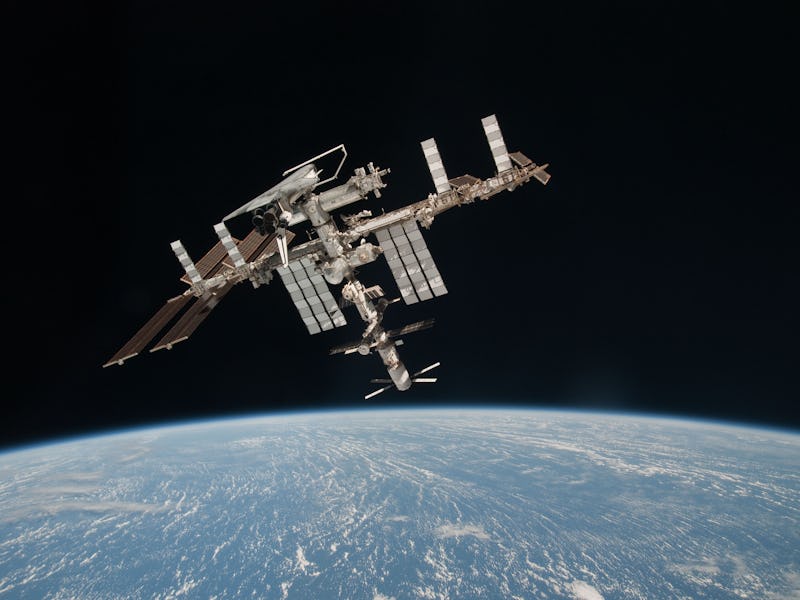Space Mining Is Going to Accelerate the Military Space Race
The U.S. military has tried for decades to put weapons in space. Russia and China are watching, and revving up.

Luxembourg made international news last week when the small European country announced its intentions to be a world leader in commercial asteroid mining. You know if Luxembourg is making big moves, the coming decades in outer space are going to be wild. The expected boom in commercial space travel and resource extraction are going to be equal parts gold rush and space race, with all the potential for riches and conflict those entail.
For decades, the United States and Russia (including when it was part of the USSR) have tried to weaponize outer space. The Reagan-era “Star Wars” program to weaponize space became a symbol of a Pentagon completely untethered from reality or any meaningful budgetary constraints. But the first “space war” was Operation Desert Storm, when U.S. forces used GPS to rout Iraq’s army following the invasion of Kuwait.
It’s been 25 years since that war, and in recent years the race for space domination has markedly increased. Stratfor, a private intelligence firm that analyzes geopolitical trends, wrote in late 2015 that “the military exploitation of space will be a defining characteristic of the 21st century.”
International law does not prohibit placing conventional weapons in space, though it does prohibit the placement of weapons of mass destruction in space. The U.S. government denies that it has any explicitly offensive weapons platforms in space. When asked directly in a 60 Minutes interview last year if the U.S. has any weapons in space, Air Force Secretary Deborah Lee James was unequivocal: “No, we do not.”
Some experts aren’t convinced. “It’s hard to say exactly how many weapons are in orbit. That’s because many spacecraft are ‘dual use,’” David Axe writes at Reuters. “They have peaceful functions and potential military applications. With the proverbial flip of a switch, an inspection satellite, ostensibly configured for orbital repair work, could become a robotic assassin capable of taking out other satellites with lasers, explosives or mechanical claws.”
Axe concludes: “The United States is, by far, the world’s most heavily armed space power.”
NASA astronaut Sunita Williams, Expedition 32 flight engineer, raises her hand during the mission's third session of extravehicular activity (EVA) September 5, 2012 in space.
It’s not entirely clear how much money the U.S. spends on military space program. According to the 60 Minutes segment, the Pentagon puts the annual price tag at $10 billion, but a White House document said the figure was more like $25 billion, including spy satellites and classified spending.
Apart from weapons, U.S. satellites play an outsized role in Pentagon operations. “Everything from GPS, early warning monitoring, weather tracking, tactical and strategic communications, and full-spectrum intelligence gathering is facilitated through the United States’ expansive network of military satellites,” writes Stratfor. “By finding a way to disable space-based systems, a potential antagonist could disconnect the multiple interlocking U.S. military systems, plunging it into information darkness and delivering a critical blow ahead of any physical strike — and to do so would not violate any existing space treaty.”
Some countries have pushed for a more comprehensive ban on outer space weapons. In 1985, the United Nations established a working group to develop the Proposed Prevention of an Arms Race in Space (PAROS) Treaty. The Reagan administration objected to the all-out ban, and efforts to draft the treaty largely ended by the mid-’90s. Russia and China introduced drafts of a treaty that would ban all weapons in space in 2008 and again in 2014, though critics have said the proposals left large loopholes for lasers, and ground-based anti-satellite weapons.
One increasingly important issue that’s tied to the weaponization and commercialization of space, is space junk. More than 500,000 pieces of space debris currently orbit the planet, traveling at speeds of up to 17,500 mph, according to NASA. Of those, NASA says 20,000 are “larger than a softball,” making them capable of damaging a space station or satellite in the event of a collision. The BBC reports that in 2014, the International Space Station had to move three times to avoid space junk. The commercial rush to low orbit promises only to exacerbate such risks.
For now, the only countries capable of competing with the U.S. in a space arms race are Russia and China, though they lag far behind. China, for one, doesn’t have the level of “space awareness” the U.S. does, Axe writes: “Where the United States can count on allies to host parts of a global sensor network, China has few formal allies and can only deploy space-awareness systems inside its own borders, on ships at sea or in space.” He adds that although the USSR had a sophisticated space program for its time, Russia has not been able to develop space weapons at the rate the U.S. can.
Tensions between the U.S. and Russia remain high, following President Putin’s annexation of Crimea and military actions in Ukraine. Russia’s air campaign against anti-government rebels in Syria and the possible fall of rebel-held Aleppo will only worsen U.S.-Russia relations. As the planet enters a period of low-level, constant warfare, outer space may well be the next frontline.